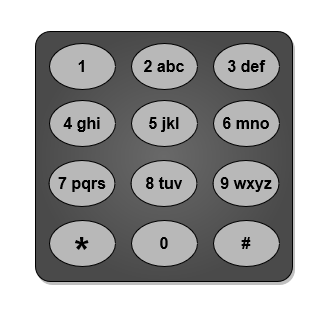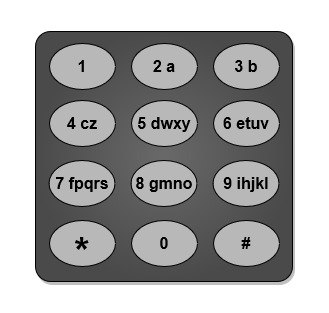3016. 输入单词需要的最少按键次数 II
题目描述
给你一个字符串 word,由小写英文字母组成。
电话键盘上的按键与 不同 小写英文字母集合相映射,可以通过按压按键来组成单词。例如,按键 2 对应 ["a","b","c"],我们需要按一次键来输入 "a",按两次键来输入 "b",按三次键来输入 "c"。
现在允许你将编号为 2 到 9 的按键重新映射到 不同 字母集合。每个按键可以映射到 任意数量 的字母,但每个字母 必须 恰好 映射到 一个 按键上。你需要找到输入字符串 word 所需的 最少 按键次数。
返回重新映射按键后输入 word 所需的 最少 按键次数。
下面给出了一种电话键盘上字母到按键的映射作为示例。注意 1,*,# 和 0 不 对应任何字母。

示例 1:

输入:word = "abcde" 输出:5 解释:图片中给出的重新映射方案的输入成本最小。 "a" -> 在按键 2 上按一次 "b" -> 在按键 3 上按一次 "c" -> 在按键 4 上按一次 "d" -> 在按键 5 上按一次 "e" -> 在按键 6 上按一次 总成本为 1 + 1 + 1 + 1 + 1 = 5 。 可以证明不存在其他成本更低的映射方案。
示例 2:

输入:word = "xyzxyzxyzxyz" 输出:12 解释:图片中给出的重新映射方案的输入成本最小。 "x" -> 在按键 2 上按一次 "y" -> 在按键 3 上按一次 "z" -> 在按键 4 上按一次 总成本为 1 * 4 + 1 * 4 + 1 * 4 = 12 。 可以证明不存在其他成本更低的映射方案。 注意按键 9 没有映射到任何字母:不必让每个按键都存在与之映射的字母,但是每个字母都必须映射到按键上。
示例 3:

输入:word = "aabbccddeeffgghhiiiiii" 输出:24 解释:图片中给出的重新映射方案的输入成本最小。 "a" -> 在按键 2 上按一次 "b" -> 在按键 3 上按一次 "c" -> 在按键 4 上按一次 "d" -> 在按键 5 上按一次 "e" -> 在按键 6 上按一次 "f" -> 在按键 7 上按一次 "g" -> 在按键 8 上按一次 "h" -> 在按键 9 上按两次 "i" -> 在按键 9 上按一次 总成本为 1 * 2 + 1 * 2 + 1 * 2 + 1 * 2 + 1 * 2 + 1 * 2 + 1 * 2 + 2 * 2 + 6 * 1 = 24 。 可以证明不存在其他成本更低的映射方案。
提示:
1 <= word.length <= 105word仅由小写英文字母组成。
解法
方法一:贪心 + 排序
我们用一个哈希表或数组 $cnt$ 统计字符串 $word$ 中每个字母出现的次数。接下来,按照字母出现的次数从大到小排序,然后每 $8$ 个字母一组,将每组中的字母分配到 $8$ 个按键上。
时间复杂度 $O(n + |\Sigma| \times \log |\Sigma|)$,空间复杂度 $O(|\Sigma|)$。其中 $n$ 是字符串 $word$ 的长度,而 $\Sigma$ 是字符串 $word$ 中出现的字母集合。
Python3
class Solution:
def minimumPushes(self, word: str) -> int:
cnt = Counter(word)
ans = 0
for i, x in enumerate(sorted(cnt.values(), reverse=True)):
ans += (i // 8 + 1) * x
return ans
Java
class Solution {
public int minimumPushes(String word) {
int[] cnt = new int[26];
for (int i = 0; i < word.length(); ++i) {
++cnt[word.charAt(i) - 'a'];
}
Arrays.sort(cnt);
int ans = 0;
for (int i = 0; i < 26; ++i) {
ans += (i / 8 + 1) * cnt[26 - i - 1];
}
return ans;
}
}
C++
class Solution {
public:
int minimumPushes(string word) {
vector<int> cnt(26);
for (char& c : word) {
++cnt[c - 'a'];
}
sort(cnt.rbegin(), cnt.rend());
int ans = 0;
for (int i = 0; i < 26; ++i) {
ans += (i / 8 + 1) * cnt[i];
}
return ans;
}
};
Go
func minimumPushes(word string) (ans int) {
cnt := make([]int, 26)
for _, c := range word {
cnt[c-'a']++
}
sort.Ints(cnt)
for i := 0; i < 26; i++ {
ans += (i/8 + 1) * cnt[26-i-1]
}
return
}
TypeScript
function minimumPushes(word: string): number {
const cnt: number[] = Array(26).fill(0);
for (const c of word) {
++cnt[c.charCodeAt(0) - 'a'.charCodeAt(0)];
}
cnt.sort((a, b) => b - a);
let ans = 0;
for (let i = 0; i < 26; ++i) {
ans += (((i / 8) | 0) + 1) * cnt[i];
}
return ans;
}
JavaScript
function minimumPushes(word) {
const cnt = Array(26).fill(0);
for (const c of word) {
++cnt[c.charCodeAt(0) - 'a'.charCodeAt(0)];
}
cnt.sort((a, b) => b - a);
let ans = 0;
for (let i = 0; i < 26; ++i) {
ans += (((i / 8) | 0) + 1) * cnt[i];
}
return ans;
}
方法二:优先队列(大根堆)
TypeScript
function minimumPushes(word: string): number {
const pq = new MaxPriorityQueue();
const cnt = new Map<string, number>();
let [i, res] = [0, 0];
for (const x of word) {
cnt.set(x, (cnt.get(x) ?? 0) + 1);
}
for (const [x, c] of cnt) {
pq.enqueue(x, c);
}
while (!pq.isEmpty()) {
const c = pq.dequeue().priority;
res += c * (((i++ / 8) | 0) + 1);
}
return res;
}
JavaScript
function minimumPushes(word) {
const pq = new MaxPriorityQueue();
const cnt = new Map();
let [i, res] = [0, 0];
for (const x of word) {
cnt.set(x, (cnt.get(x) ?? 0) + 1);
}
for (const [x, c] of cnt) {
pq.enqueue(x, c);
}
while (!pq.isEmpty()) {
const c = pq.dequeue().priority;
res += c * (((i++ / 8) | 0) + 1);
}
return res;
}